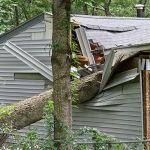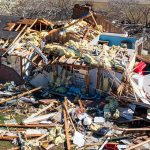What is Property Damage Coverage?
Property damage coverage can cover the cost of repairing or replacing damage to your property or belongings. It can help you recover, whether you’re the victim of a natural disaster, structural damage, or theft, to name a few.
Your individual coverage determines how much you’ll be compensated for the damage, making it essential to understand how property damage coverage works. Today’s blog examines what property damage is and how property damage coverage can help you get back to normal.
What does property damage mean?
Cornell Law School defines property damage as “injury to real or personal property.” Real property generally refers to land, while personal property includes all of your personal possessions.
The most common types of property damage include:
- Flood and water damage – Flood and water damage account for many property damage claims. Flood damage is due to rains, tidal surges, canal overflows, or runoff. Most flood damage is covered by a special flood policy (NFIP).
Water damage is due to roof leaks, pipe bursts, broken pipes, problems with condensation lines, or overflow from tubs, sinks, or toilets. - Fire and smoke – Fire quickly destroys everything in its path, making it a costly claim. A building’s wiring, furniture, and everything else can all be permanently ruined.
Smoke comes from the fire and can coat whatever the fire didn’t destroy in grease, causing even more damage. Fire and smoke can destroy your home, business, and tangible property. - Vandalism, theft, and accidents – Vandalism and theft can leave you feeling vulnerable on top of not having all your possessions and dealing with your insurance company. Even though it’s not the same, you may be able to receive compensation for what was stolen, depending on your policy.
- Wind and tornadoes – While wind is known to knock tree limbs over, it’s also a major cause of structural damage. Wind can accompany a severe thunderstorm or a tornado, which always causes widespread devastation.
Be sure to file a claim for superficial and structural damage to ensure your home is completely restored.
- Hurricanes, tropical storms, and earthquakes – These storms are just as devastating and cause extreme damage, including leaving people homeless and without basic necessities. Property damage coverage for these storms can be tricky to navigate and may necessitate a public adjuster’s help.
- Hail damage – Insurance companies are notorious for not covering hail-damaged parts of your property. They’ll find loopholes for why they won’t cover the damage.
You should contact your car insurance company if a hail storm dented your vehicle and your homeowner’s insurance if your home or property were damaged. - Structural damage – There are several types of structural damage. Examples include a car slamming into a building, snow or water getting into your property, heavy winds, foundational problems, and sinkholes, to name a few.
Structural damage can cause long-term problems if not properly resolved since a lot of the damage isn’t visible to the naked eye and requires expert analysis.
Keep in mind that this list isn’t comprehensive. If you think you have property damage but aren’t sure, contact your insurance company. They can confirm what is considered property damage and whether your policy covers the damage.
When any type of property damage has occurred, you can pay for the damages yourself, or you can file a claim with your insurance company if you have property damage coverage.
If you believe your insurance company should cover more than it offers to, a public adjuster focused on claimants can help.
Types of Insurance for Property Damage
There are a few types of insurance that cover property damage:
- General liability insurance is for third-party claims.
- Business auto policies cover third-party claims just like general liability insurance; only they are for business use instead of personal third-party claims.
- Commercial property insurance provides coverage for commercial (not business or personal) damage.
- Commercial general liability (CGL) is insurance for small businesses that protects you from third-party damage. This protection includes physical injury and loss of use to tangible property.
It’s very common for business and commercial policies to be combined. A business owners’ policy (BOP) provides general liability coverage, business interruption insurance, and property damage.
What does “loss of use” mean?
Loss of use coverage means that a third party caused damage to your property that prevented you from being able to use it.
For example, in a business setting, a plumber could make a mistake that shuts your water supply off, forcing you to close your business until the plumbing has been fixed. You can file a loss of use claim against the plumber for your lost business and inability to use your water.
What is business interruption insurance?
Business interruption insurance covers financial loss when you cannot operate your business. The insurance covers whatever is included in your policy, like a fire or flood. The insurance pays for fixed expenses like operating costs.
Say you have to temporarily relocate your business while undergoing repairs, and your temporary location is more expensive. Business interruption insurance can help cover that. It can also cover lost revenue. Approximately 30 to 40 percent of small businesses have business interruption insurance.
Have you suffered from property damage? Call Hudson Douglas Public Adjusters.
Navigating property damage can be tricky, especially if your insurance company isn’t cooperating with you. Unfortunately, many insurance companies will find ways to deny you coverage instead of taking care of your damage and getting you back to normal.
That’s where we come in. Hudson Douglas Public Adjusters act as a liaison between you and your insurance company, negotiating solely on your behalf to get you the maximum coverage possible. Our focus is on you, not the insurance company.
With locations spanning the United States and public adjusters with decades of experience, Hudson Douglas is here to provide you with high-quality service when you need it most. Call us at 800.898.4290, or fill out the form on our website to get started. We’ll get you back to normal as quickly as possible.




